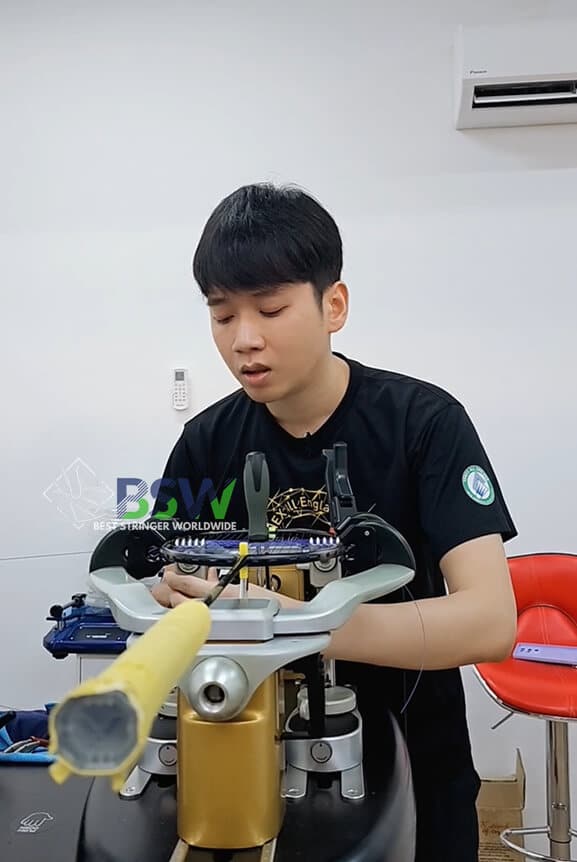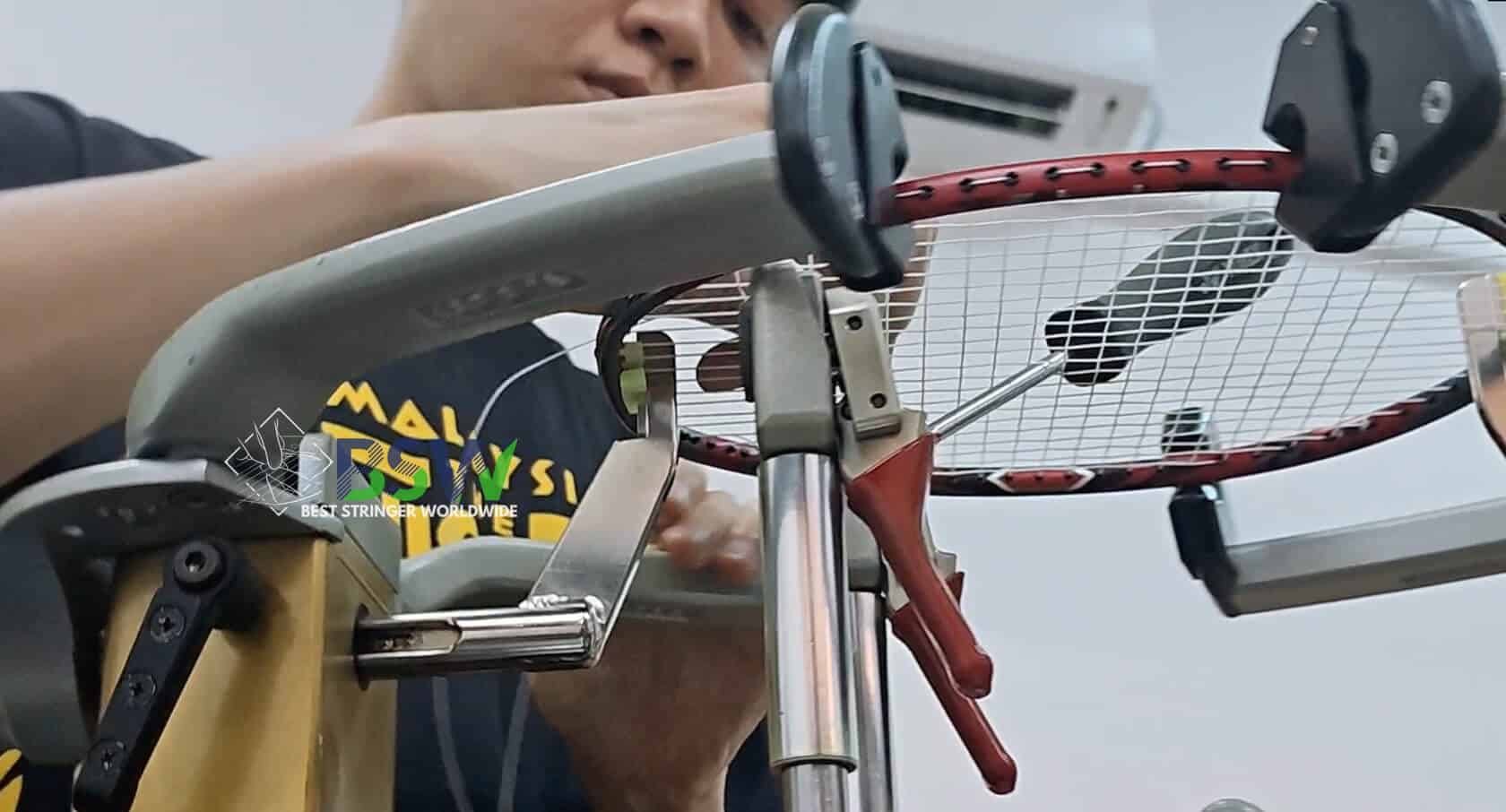Racquet sports have a rich history spanning several centuries, with modern tennis and badminton boasting over a hundred years of organized play. However, the advent of stringing machines is a relatively recent development, emerging only in the mid-20th century. This article, created by Best Stringer Worldwide (BSW) to help stringers and players improve their knowledge, explores the fascinating journey of stringing machines from their humble beginnings to the sophisticated devices we use today.
The Early Days: Manual Stringing
Before the invention of stringing machines, racquet stringing was entirely a manual process. In those early days, racquets were predominantly made of wood, and strings were crafted from natural gut or cotton. The tension applied to these strings was significantly lower than what we see in modern racquets.
String Tension Simulator
The exact origins of the first stringing machine remain somewhat shrouded in mystery. However, we do know that the earliest documented stringing devices emerged in the United States, marking the beginning of a new era in racquet preparation.
The Drop Weight Era
The first type of stringing machine to gain widespread use was the drop weight machine, which originated in the United States. These machines utilized gravity and the principle of leverage to tension strings, reminiscent of ancient Chinese balance scales. As a result, they were sometimes referred to as “scale weight” machines.
Characteristics of Drop Weight Machines:
- Simple and robust construction
- Long-lasting durability
- Accurate tension application
- Labor-intensive operation
Drop weight machines represent the most primitive form of stringing devices. Despite their simplicity, they laid the groundwork for future innovations in the field.
The Manual Crank Revolution
Approximately four decades ago, an American pilot made a significant breakthrough by inventing the manual crank stringing machine. This innovation coincided with evolving racquet materials and the introduction of various nylon and polyester strings, which demanded higher tension capabilities.
Stringing Machine Quiz
The manual crank machine offered several advantages over its drop weight predecessor:
- Increased speed of operation
- Greater control over tension application
- Improved ergonomics for the stringer
This development marked a significant step forward in stringing technology and paved the way for further advancements.

The Electric Era
As racquet materials continued to evolve and string tensions steadily increased, the industry saw the birth of electric stringing machines in the 1980s. These machines addressed the growing need for higher and more consistent tension application.
Types of Stringing Machines Based on Tension Systems
Stringing machines can be categorized into two main types based on their tension systems:
- Lock-out Machines: These machines cannot maintain tension or provide "compensation" (automatic tension adjustment).
- Constant-pull Machines: These devices can maintain tension and offer "compensation" features.
Drop weight machines and modern computerized stringing machines fall into the constant-pull category. Some early electric stringing machines, along with current manual crank models, are considered lock-out machines despite being powered by electric motors.
| Material | Durability | Power | Control | Comfort |
|---|---|---|---|---|
| Natural Gut | Low | High | Medium | High |
| Multifilament | Medium | High | Medium | High |
| Polyester | High | Low | High | Low |
| Synthetic Gut | Medium | Medium | Medium | Medium |
| Kevlar | Very High | Low | High | Very Low |
The Technology Behind Stringing Machines
It's worth noting that the underlying principles of stringing machines are not overly complex, nor do they require cutting-edge technology. Even a top-of-the-line computerized stringing machine, priced at around $5,000, contains less advanced technology than a $1,000 front-loading washing machine. This disparity is even more pronounced when comparing high-end machines to manual crank or drop weight models.
Why Are Stringing Machines So Expensive?
The high cost of stringing machines is primarily due to their limited production volumes. While a washing machine model might see millions of units produced annually, a stringing machine model may only have a production run of a few dozen units per year. To recoup research and development costs, as well as tooling expenses, manufacturers must distribute these costs across a much smaller number of units, resulting in higher per-unit prices.
Rather than lamenting the cost of stringing machines, it's more productive to focus on their potential to generate income through professional stringing services.
The Global Stringing Machine Market
Current estimates suggest that worldwide sales of stringing machines hover around 10,000 units annually. The market is dominated by two main types:
- Manual crank machines
- Computerized (electric) machines
Manual Crank Machines
These devices have a longer development history, resulting in:
- Standardized designs and construction
- Simple manufacturing processes
- Minimal differences between brands
Computerized Machines
In contrast, computerized stringing machines are still evolving, with:
- Ongoing technological advancements
- Significant variations in appearance and functionality between brands
- Continuous improvements in features and user interface
Major Production Centers
The global production of stringing machines is concentrated in several key regions:
- Taiwan: The largest manufacturing hub for stringing machines
- France: Home to Babolat and Tecnifibre production
- Japan: Where YONEX manufactures its machines
- Germany: Production site for PACIFIC machines
- Mainland China: Primarily produces entry-level and mid-range machines
Taiwan serves as a major contract manufacturer for many racquet sports brands. With the exception of the brands mentioned above and some lower-end machines produced in mainland China, nearly all other stringing machine brands are manufactured in Taiwan.
The Future of Stringing Machines
Given the significant variations in racquet shapes, particularly in tennis where racquet head sizes can differ by up to 50 square inches, and considering manufacturing cost constraints, fully automated stringing machines are unlikely to be developed in the foreseeable future. Human-operated machines will remain the primary method for racquet stringing for quite some time.
However, we can anticipate several key developments in stringing machine technology:
- Simplified Operation: Expect to see fewer required actions, such as improved clamp designs that eliminate the need for manual locking mechanisms.
- Enhanced Portability: Future machines will likely be lighter while maintaining or improving structural integrity and durability.
- Streamlined Design: Manufacturers will aim to reduce the number of components, making maintenance and repairs more straightforward.
The Importance of Professional Stringing
As stringing machines continue to evolve, the role of the professional stringer becomes increasingly crucial. A skilled stringer with a deep understanding of racquet technology, string properties, and player preferences can significantly impact an athlete's performance.
Benefits of Professional Stringing:
- Consistent tension application
- Proper knot tying and securing techniques
- Expert advice on string selection and tension
- Customization based on playing style and skill level
Many top players rely on professional stringers to maintain their equipment, recognizing the impact that properly strung racquets can have on their game.
Stringing Certification and Professional Development
For those interested in pursuing a career in racquet stringing or improving their skills, several organizations offer stringing certification programs. These programs provide comprehensive training in:
- Stringing techniques
- Machine operation and maintenance
- String and racquet technology
- Customer service and business practices
Obtaining a stringing certificate can enhance your credibility as a professional stringer and demonstrate your commitment to the craft. Some well-respected certification programs include:
- Best Stringer Worldwide (BSW) Certification
- European Racquet Stringers Association (ERSA) Certification
- CRSF
Continuous learning and staying updated with the latest stringing technologies and techniques are essential for professional stringers to provide the best service to their clients.
The evolution of stringing machines has dramatically transformed the world of racquet sports. From the early days of manual stringing to the advanced computerized machines of today, these devices have played a crucial role in enhancing player performance and racquet customization.
As we look to the future, it's clear that while the basic principles of stringing may remain constant, the tools and techniques will continue to evolve. Professional stringers who stay abreast of these developments and continually hone their skills will be well-positioned to serve the needs of players at all levels.
Whether you're a professional stringer, an aspiring technician, or a player interested in the technical aspects of your equipment, understanding the history and future of stringing machines can provide valuable insights into this essential aspect of racquet sports.
Best Stringer Worldwide (BSW) is committed to advancing the art and science of racquet stringing. By sharing this knowledge, we aim to elevate the standards of stringing worldwide and contribute to the continued growth and enjoyment of racquet sports for players of all levels.

About Best Stringer Worldwide
Best Stringer Worldwide is a comprehensive badminton and tennis stringing education program. We provide in-depth training on stringing techniques, racquet technology, and player-specific customization. Our curriculum is designed to help stringers understand and meet the needs of all badminton players, from casual enthusiasts to competitive athletes.
Read More